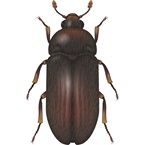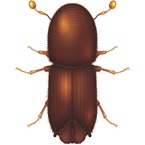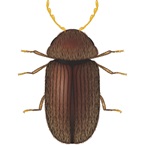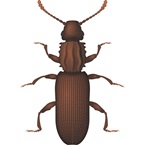Species category: Beetles & Weevils
Scientific Name: Ptinus tectus
Family: Ptinidae
Description
Adults are 2.5-4mm long, its forewings (elytra) covered with a dull-brown to golden-brown hairs.
Australian Spider Beetles have 11 segmented antennae positioned between the eyes, and share a number of spider-like characteristics including a stout body, long legs and generally, a hairy appearance.
Behaviour
Gregarious and nocturnal, Spider Beetles spend the day in cracks and crevices amongst packaging and the fabric of a building. They thrive in old buildings where they find safe harbourages.
The female can produce more than 120 eggs over 3-4 weeks. Eggs will hatch in 3-16 days depending on the surrounding temperatures, and the larvae are fleshy, curved, and covered with fine hairs.
Spider beetle larvae are relatively immobile but can rapidly curl up when disturbed. They infest all types of dry animal and vegetable matter including grain, spices and fish meal. They will scavenge on debris and bore holes in order to find a safe place to pupate. In doing so, they destroy packaging and contaminate foods.
Region
The Australian Spider Beetle is Australasian in origin and now is widely distributed. Most spider beetle species are cosmopolitan and are rarely imported.
Habitat
They enjoy dark and damp conditions and readily feed on moisture-damaged food. Infestations often originate from birds’ nests. Spider beetles are becoming increasingly common in domestic premises where they are found in store rooms, wall cavities and floorboard cracks.
Granaries and bakeries also offer the perfect conditions and food sources.
Risks
Spider beetles can reduce the quality of commodities by contaminating them with webbing and droppings. The larvae bore into packaging and the grain itself, in addition to other materials such as grain sacks, leaving behind tell-tale holes.




